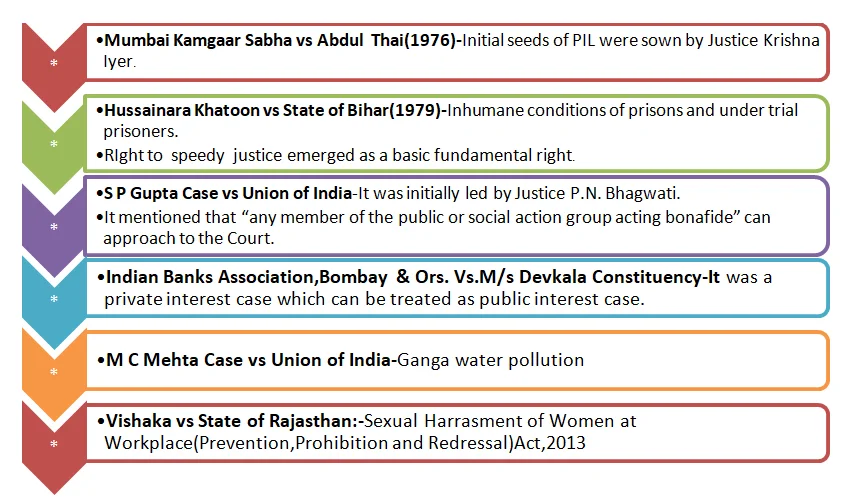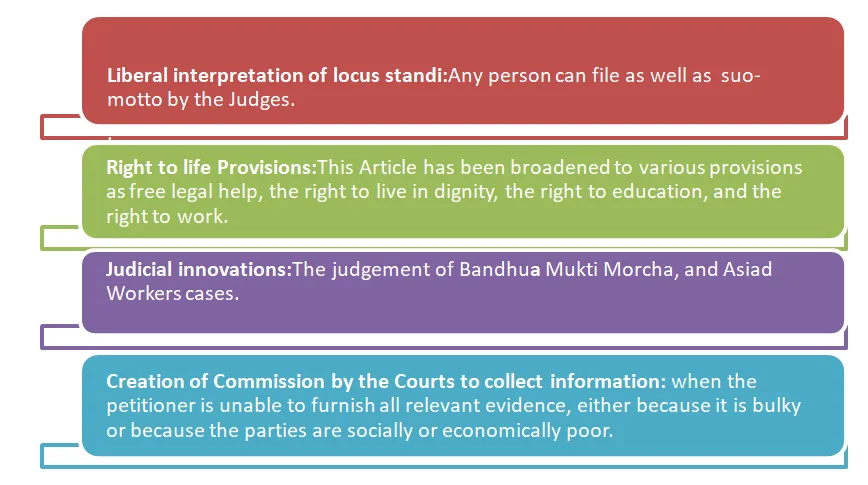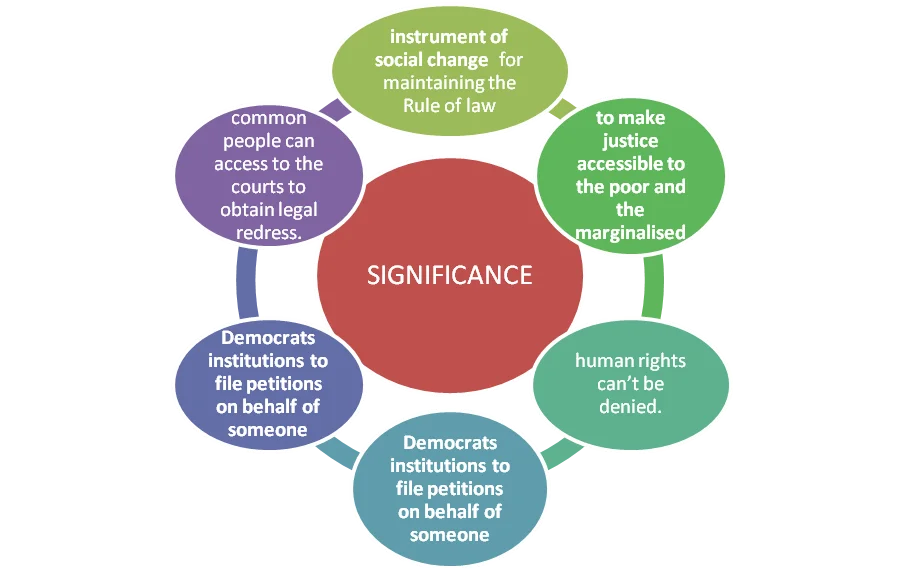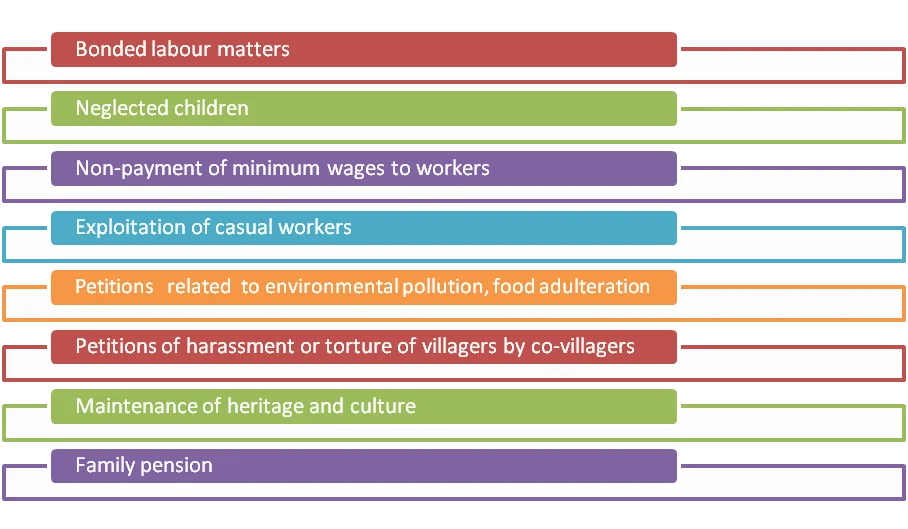Public Interest Litigation (PIL) emerged in India during the 1980s, inspired by earlier concepts from the USA. It serves as a legal tool that allows individuals or groups to seek justice for public interests, particularly for marginalized communities. PIL aims to address social issues like pollution, human rights violations, and the welfare of the economically disadvantaged. This mechanism enhances access to justice and promotes accountability among authorities.
Public Interest Litigation (PIL)
Meaning of PIL
- Definition of Public Interest Litigation (PIL): Public interest Litigation (PIL) means litigation filed in a court of law for the protection of “Public Interest”, such as Pollution, Terrorism, Road safety, Constructional hazards, etc.
- Judicial Power and Activism: It is the power given by courts to the public through judicial activism.
- It is not defined in any statute or in any act.
- However, the person must prove the satisfaction to the court for the public interest.
- Suo-Motu Action by the Court: The court can itself take cognizance of the matter and proceed suo-motu in the petition of any public-spirited individual.
Enroll now for UPSC Online Course
Purpose of PIL
- Vindication of the rule of law,
- Facilitating effective access to justice to the socially and economically weaker sections
- Meaningful realisation of the fundamental rights
Public Interest Litigation in India:
|
Features of PIL
- Strategic Arm for Justice: It is a strategic arm for the poor masses which intends to bring justice.
- Promotion of Public Interest: It is brought not for the purpose of enforcing the right of one individual against another but to promote and vindicate public interest.
- Addressing the Needs of the Disadvantaged: It notices the demands of poor or socially or economically disadvantaged people whose constitutional and legal rights are not noticed.
- Redressing Public Injury: lt is undertaken for the purpose of redressing public injury, enforcing public duty.
- Creative and Positive Approach: It is creative rather than passive and it assumes a more positive attitude in determining acts.
- Flexibility Compared to Traditional Litigations: It allows one to enjoy a degree of flexibility unknown to the trial of traditional private law litigations.
- No Adjudication of Individual Rights: For PIL there is no determination on adjudication of individual rights.
Principles of PIL
The Supreme Court evolved the following principles in regard to PIL:
- Protection of Fundamental Rights: As per Article 32 and 226 of the Constitution, it should protect the Fundamental Rights of disadvantaged people.
- Relaxation of Procedural Laws: For the publicly important cases the Court relaxes the procedural laws and also the law relating to pleadings.
- Invocation of Constitutional Articles: For injustice to a large number of people, the court should not hesitate to invoke articles 14 and 21 of the Constitution of India as well as the International Conventions on Human Rights
- Relaxation of Locus Standi: The rule of “locus standi” is relaxed to handle grievances complained on behalf of the deprived people.
- Limitations on the State: The Court may not allow the State to use PIL for raising the question for Constitutional Rights
- Consideration of Petition Nature: It would depend on the nature of the petition and also facts and circumstances of the case.
- Disputes Between Warring Groups: The dispute between two warring groups would not be allowed as a PIL.
- Appointment of Investigation Commissions: The Court may appoint a Commission for investigating the allegations and finding out facts.
- Jurisdictional Care: It should take care to transgress its jurisdiction while purporting to protect the rights of the people.
- Limitations on Writ Petitions: It should not entertain a writ petition which questions the constitutionality, statute or a statutory rule.
Who Can File a PIL and Against Whom?
Eligibility to File a Public Interest Litigation (PIL): Any citizen can file a PIL by filing a petition:
- Under Art 32 of the Indian Constitution, in the Supreme Court.
- Under Art 226 of the Indian Constitution, in the High Court.
- Under sec. 133 of the Criminal Procedure Code, in the Court of Magistrate.
- Satisfaction of the Court: But the court must be satisfied with the writ petition and it should fulfil some basic needs.
- Parties Against Whom PIL Can Be Filed: It can be filed only against a State/ Central Govt., Municipal Authorities, and not against any private party.
Genesis and Evolution of PIL

Important judgments related to PIL
There have been various significant judgments related to Public Interest Litigation (PIL) in India over the years and some of them are:
| Bandhua Mukti Morcha vs. Union of India (1984): |
|
| Rural Litigation and Entitlement Kendra (RLEK) vs. State of Uttar Pradesh (1985): |
|
| MC Mehta vs. Union of India (1987):
|
|
| People’s Union for Civil Liberties vs. Union of India (1997):
|
|
| Vishaka & Others v. State of Rajasthan & Others (1997): |
|
Factors Behind the Growth of PIL

Issues and Challenges
Competing Rights: Problem of competing rights i.e., when a court issues orders for the closure of a polluting industry, the interests of the concerned families are not taken into consideration.
- Judicial Overreach: It happens as the judiciary takes cases of socio-economic or environmental issues.
- Frivolous PILs: Frivolous PILs lead to overburden for the courts.
- Inordinate delays in the disposal of PIL.
Significance of PIL

Scope of PIL
Supreme Court Guidelines for PIL: The Supreme Court formulated a set of guidelines to be followed for entertaining petitions received as PIL in 1998.
- Modification of Guidelines: These guidelines were modified further in 1993 and also in2003.
- Categories of Letters or Petitions: Hence, according to them the letters or petitions falling under the following categories will be entertained as PIL:

Exclusions from PIL Entertainment
The following category cases will not be entertained as PIL:

Guidelines for Admitting PIL
Importance of Maintaining the Integrity of PIL: Currently, the PIL has become an important field in the administration of law.
- Therefore,It should not be allowed to become ‘Publicity Interest Litigation’ or ‘Politics Interest Litigation’ or ‘Private Interest Litigation’ or ‘Paisa Interest Litigation’ or ‘Middle-class Interest Litigation’ (MIL).
- Supreme Court’s Observations on PIL: The Supreme Court observed that:
- “PIL is not a pill or a panacea for all wrongs. It was essentially meant to protect basic human rights of the weak and the disadvantaged and was a procedure which was innovated where a public-spirited person files a petition in effect on behalf of such persons who, on account of poverty, helplessness, or economic and social disabilities, could not approach the court for relief.”
- Need for Parameters: There have been, in recent times, increasingly instances of abuse of PIL.
- Therefore, there is a need to re-emphasise the parameters within which PIL can be resorted to by a petitioner and entertained by the court.
- The following guidelines are laid down for the Supreme Court to check the misuse of the PIL
- Genuine and Bonafide PIL: Only genuine and bonafide PIL and discourage extraneous considerations.
- Formulation of Rules by High Courts: Each High Court should properly formulate rules as per them which cases to be encouraged under PIL.
- Correctness and Public Interest: The correctness and substantial public interest contents of the petition.
- Substantial public interest is involved before entertaining the petition.
- Priority for Gravity and Urgency: It involves a larger public interest, gravity and urgency must be given priority over other petitions.
- Genuine Public Harm: Must ensure that the PIL is aimed at redressal of genuine public harm and public injury.
- No Personal Gain or Motives: No personal gain, private motive or oblique motive behind filing PIL.
Impact and Challenges of Public Interest Litigation in India
- Significant Achievements: In India, Public Interest Litigation has produced significant results which were unthinkable three decades ago.
- The cases such as degraded bonded labourers, tortured under trials and women prisoners, humiliated inmates of protective women’s homes, blinded prisoners, exploited children, beggars, and many others have been given relief through judicial intervention.
- Enhancing Government Accountability: It has enhanced the accountability of the governments towards the human rights of the poor.
- Caution Against Judicial Overreach: At the same time, the judiciary should be cautious enough in the application of PILs to avoid Judicial Overreach that are violative of the principle of Separation of Power.
- Discouraging Frivolous PILs: Besides, the frivolous PILs with vested interests must be discouraged to keep its workload manageable.
Enroll now for UPSC Online Course
| Must Read | |
| Current Affairs | Editorial Analysis |
| Upsc Notes | Upsc Blogs |
| NCERT Notes | Free Main Answer Writing |
Conclusion
Public Interest Litigation has significantly transformed the legal landscape in India, providing a voice for the underprivileged and addressing critical social issues.
- While it has achieved notable successes, the judiciary must remain vigilant against frivolous PILs and judicial overreach.
- By balancing these concerns, PIL can continue to serve its intended purpose of safeguarding public interests and ensuring justice for all.
Sign up for the PWOnlyIAS Online Course by Physics Wallah and start your journey to IAS success today!
| Related Articles | |
| PIL Full Form- Public Interest Litigation | concept of the rule of law |
| Articles 14 and 21 | Supreme Court |

 GS Foundation
GS Foundation Optional Course
Optional Course Combo Courses
Combo Courses Degree Program
Degree Program












